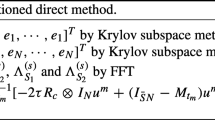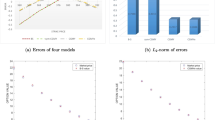Abstract
A fast preconditioned penalty method is developed for a system of parabolic linear complementarity problems (LCPs) involving tempered fractional order partial derivatives governing the price of American options whose underlying asset follows a geometry Lévy process with multi-state regime switching. By means of the penalty method, the system of LCPs is approximated with a penalty term by a system of nonlinear tempered fractional partial differential equations (TFPDEs) coupled by a finite-state Markov chain. The system of nonlinear TFPDEs is discretized with the shifted Grünwald approximation by an upwind finite difference scheme which is shown to be unconditionally stable. Semi-smooth Newton’s method is utilized to solve the finite difference scheme as an outer iterative method in which the Jacobi matrix is found to possess Toeplitz-plus-diagonal structure. Consequently, the resulting linear system can be fast solved by the Krylov subspace method as an inner iterative method via fast Fourier transform (FFT). Furthermore, a novel preconditioner is proposed to speed up the convergence rate of the inner Krylov subspace iteration with theoretical analysis. With the above-mentioned preconditioning technique via FFT, under some mild conditions, the operation cost in each Newton’s step can be expected to be \(\mathcal{O}(N\mathrm{log}N)\), where N is the size of the coefficient matrix. Numerical examples are given to demonstrate the accuracy and efficiency of our proposed fast preconditioned penalty method.




Similar content being viewed by others
References
Almendral, A., Oosterlee, C.W.: Accurate evaluation of European and American options under the CGMY process. SIAM J. Sci. Comput. 29(1), 93–117 (2007)
Benzi, M.: Preconditioning techniques for large linear systems: a survey. J. Comput. Phys. 182(2), 418–477 (2002)
Black, F., Scholes, M.: The pricing of options and corporate liabilities. J. Polit. Econ. 81(3), 637–654 (1973)
Boyarchenko, S., Levendorskii, S.: American options in regime-switching models. SIAM J. Control Optim. 48(3), 1353–1376 (2009)
Boyarchenko, S., Levendorskii, S.: Non-Gaussian Merton–Black–Scholes theory, vol. 9. World Scientific, Hackensack (2002)
Carr, P., Geman, H., Madan, D.B., Yor, M.: The fine structure of asset returns: an empirical investigation. J. Bus. 75(2), 305–333 (2002)
Carr, P., Wu, L.: The finite moment log stable process and option pricing. J. Finance 58(2), 753–777 (2003)
Cartea, A., del-Castillo-Negrete, D.: Fractional diffusion models of option prices in markets with jumps. Physica A 374(2), 749–763 (2007)
Chan, R.H., Jin, X.: An Introduction to Iterative Toeplitz Solvers, vol. 5. SIAM, Philadelphia (2007)
Chen, M., Deng, W.: High order algorithms for the fractional substantial diffusion equation with truncated Lévy flights. SIAM J. Sci. Comput. 37(2), A890–A917 (2015)
Chen, W., Wang, S.: A penalty method for a fractional order parabolic variational inequality governing American put option valuation. Comput. Math. Appl. 67(1), 77–90 (2014)
Chen, W., Xu, X., Zhu, S.: A predictor–corrector approach for pricing American options under the finite moment log-stable model. Appl. Numer. Math. 97, 15–29 (2015)
Cont, R., Tankov, P.: Financial Modelling with Jump Processes, vol. 2. CRC Press, London (2003)
Dai, M., Zhong, Y.: Penalty methods for continuous time portfolio selection with transaction costs. J. Comput. Finance 13(3), 1–31 (2010)
Elliott, R.J., Osakwe, C.-J.U.: Option pricing for pure jump processes with Markov switching compensators. Finance Stoch. 10(2), 250–275 (2006)
Fang, F., Oosterlee, C.W.: Pricing early-exercise and discrete barrier options by Fourier-cosine series expansions. Numer. Math. 114(1), 27–62 (2009)
Feng, L., Lin, X.: Pricing Bermudan options in Lévy process models. SIAM J. Financ. Math. 4(1), 474–493 (2013)
Forsyth, P., Vetzal, K.: Quadratic convergence for valuing American options using a penalty method. SIAM J. Sci. Comput. 23(6), 2095–2122 (2002)
Huang, Y., Forsyth, P., Labahn, G.: Methods for pricing American options under regime switching. SIAM J. Sci. Comput. 33(5), 2144–2168 (2011)
Itkin, A., Carr, P.: Using pseudo-parabolic and fractional equations for option pricing in jump diffusion models. Comput. Econ. 40(1), 63–104 (2012)
Jin, X.: Preconditioning Techniques for Toeplitz Systems. Higher Education Press, Beijing (2010)
Knoll, D.A., Keyes, D.E.: Jacobian-free Newton–Krylov methods: a survey of approaches and applications. J. Comput. Phys. 193(2), 357–397 (2004)
Lei, S., Fan, D., Chen, X.: A fast strategy for tempered fractional diffusion equations based on circulant preconditioning (submitted)
Lei, S., Sun, H.: A circulant preconditioner for fractional diffusion equations. J. Comput. Phys. 242, 715–725 (2013)
Lesmana, D., Wang, S.: An upwind finite difference method for a nonlinear Black–Scholes equation governing European option valuation under transaction costs. Appl. Math. Comput. 219(16), 8811–8828 (2013)
Lin, F., Yang, S., Jin, X.: Preconditioned iterative methods for fractional diffusion equation. J. Comput. Phys. 256, 109–117 (2014)
Mangasarian, O.L.: A generalized Newton method for absolute value equations. Optim. Lett. 3(1), 101–108 (2009)
Meng, Q., Ding, D., Sheng, Q.: Preconditioned iterative methods for fractional diffusion models in finance. Numer. Methods Partial Differ. Eqn. 31(5), 1382–1395 (2015)
Moroney, T., Yang, Q.: Efficient solution of two-sided nonlinear space-fractional diffusion equations using fast Poisson preconditioners. J. Comput. Phys. 246, 304–317 (2013)
Ng, M.: Iterative Methods for Toeplitz Systems. Oxford University Press, New York (2004)
Pan, J., Ke, R., Ng, M., Sun, H.: Preconditioning techniques for diagonal-times-Toeplitz matrices in fractional diffusion equations. SIAM J. Sci. Comput. 36(6), A2698–A2719 (2014)
Podlubny, I.: Fractional Differential Equations, vol. 198. Academic Press, New York (1999)
Sabzikar, F., Meerschaert, M.M., Chen, J.: Tempered fractional calculus. J. Comput. Phys. 293, 14–28 (2015)
Sachs, E.W., Strauss, A.K.: Efficient solution of a partial integro-differential equation in finance. Appl. Numer. Math. 58, 1687–1703 (2008)
Varah, J.M.: A lower bound for the smallest singular value of a matrix. Linear Algebra Appl. 11, 3–5 (1975)
Wang, H., Wang, K., Sircar, T.: A direct \(O(N\log ^2N)\) finite difference method for fractional diffusion equations. J. Comput. Phys. 229(21), 8095–8104 (2010)
Wang, I., Wan, J., Forsyth, P.: Robust numerical valuation of European and American options under the CGMY process. J. Comput. Finance 10(4), 31 (2007)
Wang, W., Chen, X., Ding, D., Lei, S.: Circulant preconditioning technique for barrier options pricing under fractional diffusion models. Int. J. Comput. Math. 92(12), 2596–2614 (2015)
Wilmott, P., Dewynne, J., Howison, S.: Option Pricing: Mathematical Models and Computation. Oxford Financial Press, Oxford (1993)
Witte, J.H., Reisinger, C.: A penalty method for the numerical solution of Hamilton–Jacobi–Bellman (HJB) equations in finance. SIAM J. Numer. Anal. 49(1), 213–231 (2011)
Yousuf, M., Khaliq, A., Liu, R.: Pricing American options under multi-state regime switching with an efficient L-stable method. Int. J. Comput. Math. 92(12), 2530–2550 (2015)
Zeng, P., Kwok, Y.: Pricing barrier and Bermudan style options under time-changed Lévy processes: fast Hilbert transform approach. SIAM J. Sci. Comput. 36(3), B450–B485 (2014)
Acknowledgements
The authors would like to thank Prof. Che-Man Cheng and Mr. Yun-Chi Huang in University of Macau for their helpful discussions, and also the referees for their valuable comments and suggestions which improved the quality of this article.
Author information
Authors and Affiliations
Corresponding author
Additional information
This work was supported by the research Grants MYRG2016-00202-FST and MYRG068(Y4-L2)-FST13-DD from University of Macau, 081/2016/A2 and 048/2017/A from Macao Science and Technology Development Fund (FDCT).
Appendices
Appendix A: Derivation of the Eq. (4)
According to the no arbitrage condition and Itô’s formula for switching Lévy process, European claim price must satisfy the following system of partial integro-differential equations [13]:
where \(\mathcal {L} V_s(x,t)\) is the generator of the switching Lévy process:
Applying the Fourier transform to (22), by means of the condition (ii) of the intensity matrix \(\mathcal{Q}\) and (3), leads to the following equations \(\forall s \in \mathcal{S}\),
where the exponential Fourier transform is defined by
From [8], we have
By inserting specific characteristic exponent (24) into (23), the system of TFPDEs (4) can be derived from the inverse Fourier transform. To be noted that the Fourier transforms of the left-sided and right-sided tempered fractional operators are given by [10, 32, 33]
Appendix B: Monotonicity of the Newton’s Iteration
From the algorithm (18),
Then replacing \(\bar{g}((\bar{u}_s^{(m)})^{k})\) by its definition (17), we have
where \((\bar{u}_s^{(m)})^{0}=\tau f_{s}+u_{s}^{(m-1)}-\tau \sum _{\tilde{s}\in \mathcal{S}}q_{s \tilde{s}}u^{(m-1)}_{\tilde{s}}\).
Noting that \(\mathcal{\tilde{I}}_s^k (\bar{u}_s^{(m)})^{k}-{\mathcal{N}}^{(m)}_{s}=\mathcal{\tilde{I}}_s^k u_s^*\). Finally, the Newton’s method (18) can be simplified to the following algorithm, which gives for all \(s \in \mathcal{S}\),
Given that \(\mathcal{M}_s\) is an M-matrix, by following the idea from [18], we can prove that the Newton’s iteration converges monotonically. For the monotone property, writing equation (25) for iteration \(k\ge 1\) as:
Subtracting equation (26) from (25) gives
Under the both cases: \(u_{n,s}^*-(\bar{u}_{n,s}^{(m)})^{k}\ge 0\) and \(u_{n,s}^*-(\bar{u}_{n,s}^{(m)})^{k}< 0\) in the pointwise, we have
Note that all of the elements of the inverse of an M-matrix are nonnegative. Since the matrix \(\mathcal{M}_s-\tau \rho \mathcal{\tilde{I}}_s^{k}\) is an M-matrix, we can see that the Newton’s iteration is monotonically decreasing for the iteration step \(k\ge 1\). Similar with the technique used in [18], we can also prove the uniqueness of the penalty iteration given that the matrix \(\mathcal{M}_s\) is an M-matrix.
Rights and permissions
About this article
Cite this article
Lei, SL., Wang, W., Chen, X. et al. A Fast Preconditioned Penalty Method for American Options Pricing Under Regime-Switching Tempered Fractional Diffusion Models. J Sci Comput 75, 1633–1655 (2018). https://doi.org/10.1007/s10915-017-0602-9
Received:
Revised:
Accepted:
Published:
Issue Date:
DOI: https://doi.org/10.1007/s10915-017-0602-9
Keywords
- American options
- Linear complementarity problems
- Regime-switching Lévy process
- Nonlinear tempered fractional partial differential equations
- Unconditional stability
- Fast preconditioned penalty method




